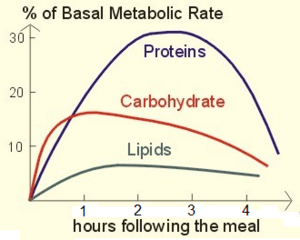Metabolic rate facts for kids
Metabolic rate is the rate of metabolism, the amount of energy used by an animal per unit of time. Basal metabolic rate (BMR) is the amount of energy used daily by animals at rest.
| Energy expenditure breakdown | |
|---|---|
| Liver | 27% |
| Brain | 19% |
| Heart | 7% |
| Kidneys | 10% |
| Skeletal muscle | 18% |
| Other organs | 19% |
About 70% of a human's total energy use is due to the basal life processes within the organs of the body (see table). About 20% of one's energy use comes from physical activity and another 10% from the digestion of food after eating.
All of these processes require an intake of oxygen to provide energy for survival, usually from macronutrients like carbohydrates, fats, and proteins. The Krebs cycle produces energy-rich ATP molecules, and gives off carbon dioxide.
Contents
Basal metabolism
Basal metabolism is usually by far the largest component of total energy used. The release, and using, of energy in this state is sufficient only for the functioning of the vital organs, the heart, lungs, nervous system, kidneys, liver, intestine, sex organs, muscles, and skin.
Biochemistry
For the BMR, most of the energy is consumed in maintaining fluid levels in tissues through osmosis, and only about one-tenth is consumed for mechanical work, such as digestion, heartbeat, and breathing.
What enables the Krebs cycle to perform metabolic changes to fats, carbohydrates, and proteins is energy, which can be defined as the ability or capacity to do work.
The breakdown of large molecules into smaller molecules – associated with release of energy – is catabolism. The breakdown of proteins into amino acids is an example of catabolism. Body heat in warm-blooded animals is produced by chemical reactions of the catabolic type.
The building up process is termed anabolism. The formation of proteins from amino acids is an anabolic process.
Adenosine triphosphate (ATP) is the intermediate molecule that drives the transfer of energy used in muscle contraction. ATP is a high energy molecule because it stores large amounts of energy in the chemical bonds of the two terminal phosphate groups. The breaking of these chemical bonds in the Krebs cycle provides the energy needed for muscular contraction.
Individual differences
The metabolic rate varies between individuals. One study of 150 adults representative of the population in Scotland reported basal metabolic rates from as low as 1027 kcal per day (4301 kJ) to as high as 2499 kcal (10455 kJ). The average was 1500 kcal (6279 kJ) per day.
The researchers calculated that 62.3% of this variation was explained by differences in the mass (weight) minus the fat reserves. Other factors were the amount of fat (6.7%), age (1.7%), and experimental error including within-subject difference (2%). The rest of the variation (26.7%) was unexplained.
So there are differences in BMR even when comparing two subjects with the same lean body mass. The top 5% of people are metabolizing energy 28-32% faster than individuals with the lowest 5% BMR. For instance, one study reported an extreme case where two individuals with the same lean body mass of 43 kg had BMRs of 1075 kcal/day (4.5 MJ) and 1790 kcal/day (7.5 MJ). This difference of 715 kcal (67%) is equivalent to one of the individuals completing a 10 kilometer run every day.

Scaling effects
Metabolic rates vary according to animal size, and this has been discussed for over a century.
The graphs show that :
- The metabolic rate of mammals is a regular function of their body size, and
- The function is significantly different from a direct function of their body surfaces.
- On a log-log scale, the metabolism of mammals as related to their body size forms a straight line with a slope of about 0.75.
- Later research showed that similar relationships hold for 'cold-blooded' animals and protists.
Images for kids
See also
 In Spanish: Tasa metabólica basal para niños
In Spanish: Tasa metabólica basal para niños




